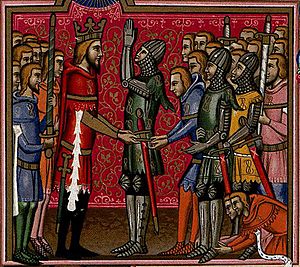Paladin facts for kids

A paladin was a very important person in many countries during the Middle Ages and in early modern Europe. The word "paladin" also describes a brave and honorable knight in old stories.
The word "paladin" first came from Ancient Rome. It was used for a special helper to the Emperor, called a chamberlain. It also described the Emperor's special guards, known as the Scholae Palatinae. These guards were named by Constantine the Great.
Later, in the early Middle Ages, the meaning changed. A paladin could be a high-ranking official in the Catholic Church who worked for the pope. It also meant a powerful noble in the Holy Roman Empire, who was called a Count Palatine. The word was even used in Hungary in the 1800s and in Germany and the United Kingdom in the early 1900s.
In medieval literature, especially in stories about Charlemagne called the Matter of France, the paladins were a group of twelve brave knights. They were Charlemagne's most trusted followers. Because of these stories, a paladin became known as a knight who was very honorable and courageous.
Contents
Paladins Through History
Ancient Roman Paladins
The first paladins were part of the Roman Emperor's guard. They were called the Scholae Palatinae.
At first, the word "paladin" was used for the Emperor's special helpers, the Chamberlains. It also described some soldiers who guarded the Roman Emperor's palace. During the time of Emperor Constantine, the word also meant the best infantry (foot soldiers) in the army. These soldiers, like the Praetorian Guard, might even guard the Emperor during wars.
Paladins in Medieval Europe
After the Middle Ages, the word "palatine" was used for many powerful people across Europe. One of the most important was the comes palatinus, or count palatine. During the Merovingian dynasty and Carolingian Empire times, this person was an important official in the lord's household and court of law.
Around the 800s, the Carolingian rule ended, and so did the title of Holy Roman Emperor. About 100 years later, Otto I brought the title back. The new empire was now based in Germany, not France. The term palatine appeared again under Charles IV. However, these new palatines had less power than the earlier ones.
Paladins in Modern Times
In early England, the word palatinate was used for certain counties. These were areas where local lords could use powers that usually only the king or queen had.
In Britain and Germany, "paladin" was an official rank. It was a very respected title for someone serving the emperors. A paladin was a Knight with extra honors. They were allowed to use powers that were usually reserved for the crown.
Paladins Today
The word "paladin" is still used today. It describes a good, heroic person. It can also mean someone who strongly defends a good cause.
Some role-playing games now let you choose a paladin as a character. This character class usually represents a brave and righteous warrior.
Images for kids
See also
 In Spanish: Paladín para niños
In Spanish: Paladín para niños



